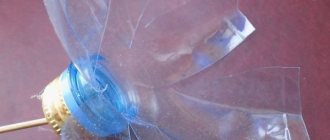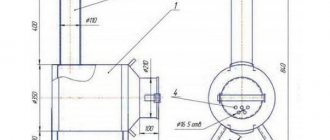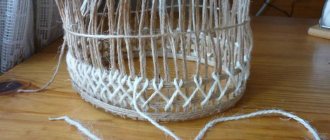Throughout the long winter, we look forward to pleasant summer days, and with the onset of hot weather, for some reason we begin to dream of coolness. How delightfully a light breeze created by a small homemade fan will help restore strength and relieve fatigue. Plus, making it is incredibly fun, right?
We invite you to familiarize yourself with step-by-step instructions for assembling simple, effective devices from literally waste raw materials. The article presented to your attention describes in detail how to make a fan with your own hands and what a home craftsman will need for this.
At your disposal is a detailed description of the manufacture of options, the effects of which have been tested in practice. You can make such devices yourself without having any experience at all. For a complete understanding of the information, step-by-step photos and video instructions are included.
A simple homemade product from CDs
The simplest fan can be made from CD discs. It can be used, for example, for local impact on a user who spends a long time at the computer.
Let's prepare the raw materials to complete the work:
- CD discs – 2 pcs.;
- low-power motor;
- wine bottle cork;
- cable with USB plug;
- a tube or rectangle made of thick cardboard;
- soldering iron;
- candle or lighter, hot glue;
- pencil, ruler, squared paper.
For our purposes, you can use a motor from an old toy, for example, from a toy car. A toilet paper roll slightly decorated with decorative finishing paper can be used as a cardboard tube.
The main advantage of this model is that almost any do-it-yourselfer will have all the materials needed for its manufacture.
The assembly process of the mini fan is quite simple.
Let's take one of the CDs and use a marker to divide its surface into eight equal sections. The easiest way to do this is to use a sheet of checkered paper.
Draw a cross on it from a horizontal and vertical line. We divide each of the four resulting right angles in half. Using cells, this is not difficult to do.
Using a very simple method using a checkered piece of paper, we can achieve the ideal layout of the disk into eight equal sectors
We place a disk on our drawing so that the intersecting lines are in the very center of its hole. Alternately applying a ruler to the lines diverging from the center, we make markings on the disk. This way the sections will be the same.
To divide the disk into blades, follow the marking lines with a soldering iron from the transparent part to the edge.
You can also use scissors for cutting, but there is a danger that the workpiece will crack during the process. If you don’t have a soldering iron, you need to use a knife preheated on the stove. When working with a soldering iron, deposited plastic is formed along the edges of the cut, which can be easily removed with a knife.
Cutting a disk with a soldering iron is the most effective method in which the workpiece will not crack or deform, and the remnants of the deposited plastic can be easily removed with a knife
We heat the surface of the disk over the flame of a burning candle so that the blades can be slightly expanded. If you don't have a candle, a lighter or a soldering iron will do.
The central part of the disk should be heated, and all blades should be turned in the same direction. A wine cork is placed in the hole of the disc. To fix it better, you need to pre-treat the edges of the hole with hot glue.
The USB cable must be connected to the motor. If we don’t guess the direction of rotation of the propeller, we can swap the reins, that is, change the polarity.
The motor needs to be glued to a cardboard tube, and the tube itself to a second CD, which will act as the base of the stand.
When the plug is installed in the hole, the stand from the second CD and cardboard tube, as well as the connecting device are already assembled, it is very important to correctly fit the propeller onto the motor shaft
Now the propeller needs to be “planted” on the rod of the future fan. We will try to make sure that it is installed strictly in the center. You can secure it in this position using hot glue.
After all work is completed, the fan is ready for use.
Although the construction of this device will not take you much time, the result of the work performed will undoubtedly please you
How to make a similar, but slightly more complex design by including a regulator in the circuit, look at the video posted at the end of this article.
Do you find these homemade instructions complicated? Then you may be interested in information about the types of fans and the rules for choosing them in order to purchase a ready-made device offered by manufacturers of household appliances.
How to choose the right equipment
To make the work of a nail specialist as comfortable as possible, it is recommended to choose a vacuum cleaner for manicure according to the following characteristics:
- high performance - the device must effectively suck up dust before it spreads throughout the room;
- high-quality material of the dust collector - it is impossible for the bag to let the dust particles collected into it pass through;
- compactness - the vacuum cleaner should not take up much space on the manicure table and interfere with the specialist performing the procedure;
- noiselessness - loud sound when the equipment is operating leads to irritability, loss of attention, fatigue of the master, which significantly affects the quality of the procedure and the final result.
There are the following types of manicure vacuum cleaners:
- portable desktop device is the most popular. It can be used at a permanent workplace or taken with you for nail extensions at a client’s home. This vacuum cleaner is a small device in the form of a hand rest, which is why it performs a double function - it collects dust and allows the client to position his hand comfortably, in addition, it significantly helps the master in his work. When choosing a device of this type, you should pay attention to the material of its body. The most comfortable surface for the client is considered to be one covered with soft leatherette, resistant to solvents and other agents. It will also be a plus if the tabletop device is additionally equipped with a lamp, which will save space on the manicure table;
- stationary equipment - used only at a permanent workplace, since it is built above or below the manicure table (the grille from the vacuum cleaner is placed on the tabletop). The advantage of such a device is that it does not take up space on the work surface, and it has more power than a desktop vacuum cleaner. However, the cost of such equipment is higher.
Each nail specialist can choose the most suitable design for himself, depending on whether he does a manicure in a salon, at home, or works on the road.
Modern stationary hoods are equipped with powerful lamps, which makes the master’s work easier and saves space on the manicure table.
Fan based on a plastic bottle
What our craftsmen don’t do from plastic bottles! The time has come to say that they also make a very good fan. It may not ventilate your entire room, but it will definitely help those who have to work at a computer.
We offer two options for creating such a fan model.
Option #1 - hard plastic model
To complete the work we will need:
- plastic bottle with a capacity of 1.5 liters;
- a motor from an old toy;
- small switch;
- Duracell battery;
- marker;
- scissors;
- candle;
- hammer and nail;
- Styrofoam;
- hot glue gun.
So, we take an ordinary 1.5 liter plastic bottle with a stopper. At the level of the label line, cut off its upper part. This is exactly what we need to make the propeller. We divide the surface of the plastic blank into six parts.
We try to mark it out so that we get equal sectors: the quality of operation of the future device depends on this.
We cut the workpiece along the markings almost to the neck. We bend the blades of the future propeller and cut off every second of them. We are left with a blank with three blades equidistant from each other. The edges of each blade must be rounded. We do this carefully.
To remove those parts of the blades that are closer to the neck of the workpiece, it is better to use a utility knife; do not forget to round the edges of the blades
Now we will need a small candle. Let's light it up. We heat each blade at the base on it to turn it in the direction we need. All blades must be turned in the same direction. Remove the lid from the workpiece and punch a hole in the very center using a nail and hammer.
We place the plug on the rod of a small motor. Such motors can remain from old children's toys. As a rule, getting them is not difficult. Secure the cork with glue.
Now you need to make a base on which the motor will rest. For this purpose, we take, for example, a piece of polystyrene foam. We attach a rectangle to it, which can also be cut out of foam packaging.
Our motor, to which the propeller is attached, will be fixed on the upper surface of this rectangle. To do this, you need to make a recess in the foam that corresponds to the parameters of the motor.
Hot melt adhesive is used to secure the elements of the product. If it is unavailable, other adhesives can be used. It is important that the fastening itself is as reliable as possible.
Polystyrene foam is a convenient material for constructing a fan stand, because it is easy to give it the desired shape, but it is better to make the base of the stand heavier.
A small switch and a power supply, the role of which is played by a rectangular Duracell battery, are attached to a foam stand. We assemble the simplest chain, trying to do everything as carefully as possible.
All we have to do is screw the propeller onto the plug fixed on the motor. Our fan is completely ready for operation.
The foam stand probably weighs too little to give the device the necessary stability. After all, with a sufficient span of blades, it can turn out to be quite powerful. Therefore, it is advisable to make the base of the model heavier.
Option #2 - soft polymer product
Let's prepare in advance everything that we will need during the work:
- two bottles of SevenUp lemonade;
- electric motor 12 V DC;
- seven thick straws for drinks;
- connector for power supply;
- the power supply itself;
- switch;
- scissors and utility knife;
- marker;
- hot glue gun;
- Super glue;
- plastic ties;
- wire cutters;
- soldering iron;
- insulating tape;
- CD disk.
So, there is another option for building a homemade fan from a plastic bottle. Let's take a bottle of smaller capacity, for example, SevenUp lemonade.
The algorithm for cutting the blades of the future propeller is the same as in the previous version. The plastic of this bottle is much softer, so you can give the desired slope to future blades without resorting to heating them.
A hole in the center of the cork should be made using an awl or nail heated over a fire for this purpose. The 12 V DC electric motor, on the shaft of which the propeller will be attached, can be taken from old toys or a hairdryer that is unnecessary in the household.
The cover is fixed to the shaft using hot melt adhesive. We immediately screw the light propeller to the lid.
When talking about this option for constructing a fan, we mentioned seven tubes, but if the tubes you have have a smaller diameter, you will need more of them: you need them to fit tightly into the neck of the lower workpiece
The most interesting thing is the construction of the stand. It turns out to be not only stable, but also attractive. To create it you will need seven thick drinking straws. It is necessary to glue them together with superglue. It turns out to be quite a strong and attractive stand.
For the base, take the top part of a plastic bottle larger than the one from which we made the propeller. We push the stand of tubes into the neck of the workpiece, approximately to the middle of its length. We fix the stand in this position using superglue applied to the neck of the workpiece.
Now you can install the engine on the rack, securing it with hot glue. The fact that the stand itself is made of hollow tubes helps hide the wires nicely. We simply pass them through the central tube. This way the wires end up inside the base of the device.
To further strengthen the structure, you should use plastic ties, which are glued with hot glue to the stand on the sides of the motor so that the tie lock is tightened over the motor itself, ensuring its immobility. The excess tip of the fastener is removed with pliers.
In the plastic surface of the bottle, which serves as the base of the structure, holes are cut for the power supply connector and switch. It is better to do this with a utility knife.
We connect the connector for the power supply and the switch. The wires should be soldered and insulated. The switch and connector are fixed to the plastic with hot glue.
The CD disk, which becomes the bottom for the base of the future fan, is not only the finishing touch of the work, but also makes the product more stable
To make the base heavier and more stable, we will build a bottom for it from a CD.
To do this, lubricate the edges of the plastic blank with hot glue and press the disk against it.
The motor is connected to the power supply via a connector, and the device itself is turned on using the red button located on the left
Now we connect power through the connector. For this purpose, you can use a power supply for LED strips, which is sold in electrical appliance stores. Well, this homemade product is ready to go.
To make sure that you correctly understand the sequence of work performed, watch the video at the end of this article.
Why do you need a manicure vacuum cleaner?
Nail extensions allow women to make their hands well-groomed and attractive. However, when filing gel or acrylic nails, a large amount of dust is generated, which contains many harmful components.
When filing extended nails, a lot of harmful dust is generated
Prolonged inhalation of fine particles leads to their settling on the mucous membrane of the respiratory tract, which can give rise to the development of certain diseases:
To prevent such unpleasant consequences, manicurists use special vacuum cleaners when removing gel nails.
Video: manicurist on the benefits of a manicure vacuum cleaner
Stylish product without blades
We are accustomed to the fact that the main part of the fan is the propeller. This design part rotates, creating the necessary air flow.
But there are also bladeless models. They have become fashionable, primarily due to their safety for younger family members and pets. In addition, these products look stylish: they can fit into any interior and decorate it.
The finished bladeless fan is completely different from the device we are used to seeing, however, it works great
Like most other things that serve a person, a bladeless fan can also be made with your own hands.
The principle of its operation is simple: at the base of the device there is a small turbine, which allows you to create air flows passing through the side openings.
For work we will need:
- computer cooler;
- power supply unit and connector;
- small switch;
- hot glue gun;
- cardboard or thick paper;
- scissors, pencil, ruler, compass and caliper.
In principle, we need a caliper solely in order not to make a mistake in the dimensions of the product. If it is not available, then you can get by with a regular ruler, tape measure or measuring tape.
Let's get to work.
First, let's make the body - the base of the product. To do this, cut out four rectangular pieces of cardboard. To determine the parameters of the base, measure the width of the cooler. The resulting size will match the width of the rectangles.
For convenience, we will operate with specific sizes. The width of our cooler is 120 mm. This means that the width of the rectangle is also 120 mm.
A small switch and power connector will be built into the body of our product. In order for them to stay tight enough in the future, you need to take measurements from them.
The holes in the housing must correspond to the obtained values. You need to make holes until the rectangles become part of the body: cutting them out in flat objects is always easier.
We need a twelve-volt power supply and a corresponding cooler that consumes only 0.25A. Taking into account the fact that we have a 2A unit, we can assume that we are quite well prepared for the further operation of the future device.
Now we take sheets of cardboard from which we have to cut out the elements of the main part of the fan. First, let's draw two circles. The radius of each of them is 15 cm. Cut out both circles.
In one of them, let's call it A, we will draw an inner circle with a radius of 11 cm. In the second, which we will call B, the radius of the inner circle will be 12 cm. Carefully cut out the inner circles. We received rings A and B.
The resulting rings will be attached to the body of the product. In order for them to better adhere to the surface of the body, we will apply one of the rectangular blanks to each of the rings and cut off a segment, the flat side of which corresponds to the width of the rectangle.
In order to reliably glue the rings to the base on which they will be installed, it is necessary to ensure the maximum contact area: for this purpose, a sector is cut off at the bottom of the product
The main part of a bladeless fan is cylindrical in shape. To make it, we need strips of cardboard with the following parameters: the first - 12x74cm, the second - 12x82cm, the third -15x86cm. During the assembly process it will become clear what to do with each of these three strips.
Before assembling the body, cut a notch in the bottom of each rectangle. This way we not only make legs for the future fan, but also create channels for incoming air.
The recesses in the lower part of the base can be made in a rectangular shape, but it is better to add an arc to the original rectangle, drawing it using a CD disk
We will assemble the body using hot melt glue. The cooler should be located approximately in the central part of the case, surrounded by four rectangles that form the walls of the structure. Lubricate the cooler around the perimeter with glue and surround it with walls.
Don't forget that the notches in the walls that we just cut should be at the bottom of the case.
The wires from the cooler can be tucked into a corner of the structure, securing them in this position with glue.
At this stage it is best to mount and connect. Since we are using a switch, we need to split one of the wires and form a circuit.
The wires should be connected to the power connector (red - positive, black - negative). If we get the polarity wrong, we just need to swap the wires. Using hot glue, we secure the connector and switch in the places intended for them.
We connect the power and check if the turbine is working. If everything is in order, we continue assembling our bladeless model.
We take ring A, which will be located in the front of the device, and the first strip (12x74cm). We close the strip into a circle and glue it into the inner circumference of ring A. The result is something like a cylinder hat without a top, but with a brim. The same must be done with ring B and the second strip (12x82cm).
This kind of hat came out of ring A and the first strip that we glued along the inner circumference of the ring
We glue the first “cylinder” to the front side of the body in the place where we cut off the segment. We also glue the second “cylinder” to the back side of the body with a cut surface. In this case, the smaller “cylinder” ends up inside the larger one.
The stability of the structure can be imparted using five strength partitions, fixed between the rings using the same glue. They need to be cut out of cardboard. The length of the partitions should be slightly less than 12cm.
Now the side surface of the main structure should be covered with the remaining third strip of cardboard (15x86cm).
This photo shows the internal structure of the fan quite clearly, which will be hidden from us by the last (third) strip
In principle, the fan is ready. All that remains is to give it an external gloss. To do this, remove excess glue and cover its outer surfaces with paint or decorative paper.
You may also find the information on fan speed controls contained in our other article useful.
So that you can see how correctly you understood and did everything, watch the video on how to create a bladeless fan yourself, which we placed at the end of this article.
If you are interested in assembling interesting and useful devices, then you may be interested in the information about making an air conditioner at home, discussed in our other article.
And in the cold season, you can assemble a heater or a homemade fan heater using a minimum of materials.
Review of the most popular models
Novice manicurists most often receive clients at home, and therefore wonder which brand of desktop vacuum cleaner is best to choose.
The most popular models of mobile hoods are provided by the following manufacturers:
- Ultratech - vacuum cleaners from this company are distinguished by their virtual absence of noise and a long warranty period (24 months). The device meets all necessary requirements.
- Salon Professional - devices are produced by an American company and are characterized by a powerful built-in fan, which allows you to instantly clean the air of contaminants.
- Lady Victory - the manufacturer made sure that Lady Victory devices were as comfortable as possible for the client, so their body is covered with soft material. The company offers many colors of leatherette to choose from.
- Planet Nails - vacuum cleaners of this brand combine good quality and low cost. In addition, Planet Nails models are distinguished by their compactness.
- Simei - instrument bodies are made of high-quality plastic and equipped with a soft rubberized lining for the client’s hands. A big advantage of the device is that it has a built-in convenient LED lamp that provides good lighting. The suction power of the vacuum cleaner reaches a distance of 10 cm.
Photo gallery: popular models of manicure vacuum cleaners
How to make your own manicure hood
There are many videos on the Internet with reviews of tabletop manicure hoods. Their design is quite simple: a fan is built into the case, under which there is a dust collection bag. Therefore, making such a hood yourself will not be difficult. To do this, you need to be able to work with a soldering iron and prepare the necessary parts.
Vacuum cleaner from a computer cooler
You can create a tabletop hood from a computer cooler using materials that almost everyone has at home, but if not, then they are easy to find in any hardware store. So, for a homemade device you will need the following parts:











